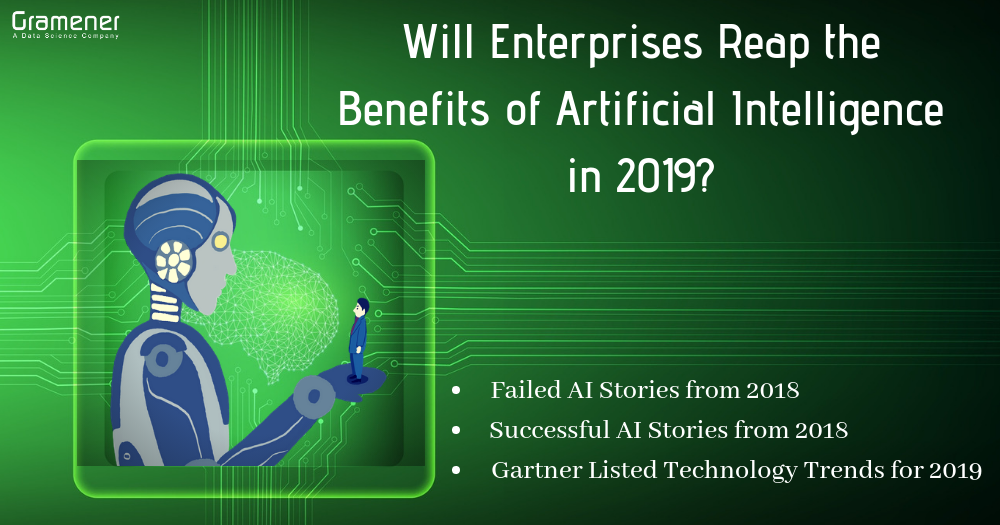Artificial Intelligence is not just hype and its actual business implementations are helping enterprises taste the benefits of Artificial Intelligence, adding value to the business.
Businesses are transforming digitally, and industries are embracing the potential impact of AI-driven solutions. According to a recent IDC report, 75% of the enterprise application will be AI-driven by 2021. Enterprises are strong including multiple cognitive/Artificial Intelligence solutions to create and drive enterprise-grade applications.
A Recap of 2018 on AI Trends
Before talking about the distant predictions, we might want to take a recap of a few AI failures that covered the news in 2018.
Before you judge the above infographic, let us tell you that the review of AI failure is necessary to showcase the fledgeling technologies and biased data that produce blunders not envisioned by humans.
But every coin has two faces and the bright side of AI is that it has offered some extraordinary products and services in 2018.
Analysing the upsets and successes of AI in the past year, we can conclude that no matter what, Enterprises are readily investing in AI/ML/DL to harvest troves full of data and enhance data-driven leadership. With a budding future of AI/ML in the technology vertical educational organizations such as Springboard are offering information in designing ML/DL systems. This adds real value to the existing knowledge database on the subdomains of AI.
The Recent AI Trends
Low code machine learning and AI applications are gonna take over soon replacing the code-heavy development approaches. Low-code analytics platforms that offer the sweet spot between custom development and rapid BI building will offer both flexibility and fast development.
In the last couple of years, not only small enterprises but also Giant tech-driven organizations have leveraged AI to add value to their businesses.
- Facebook in the second half of 2018 announced that they would be implementing AI, VR, and AR at the annual F8 Conference.
- Baidu, the Chinese IT Product and Service company is also deliberately saying goodbye to the Era of Mobile Internet and investing heavily on AI.
- Telecom giants such as Vodafone are taking benefits of Artificial Intelligence to enhance their customer experience and cost-effectiveness.
- JP Morgan and Chase
is investing in AI to achieve better employee productivity and high finance. - As per a Global CIO Survey, Deloitte, the leading audit, consulting, and tax advisory company calls AI to receive 64% of total investment in data science.
“Artificial Intelligence (AI) will transform enterprises and the processes in it. AI is extensively poised to deliver promising technologies.” Says Nutan B, Director – Data science at Gramener in his blog – Real Benefits of Artificial Intelligence.
Gartner listed top AI trends for 2019
“The future will be characterized by smart devices delivering increasingly insightful digital services everywhere,” said David Cearley, Gartner Distinguished Vice President-Analyst, at Gartner 2018 Symposium/ITxpo in Orlando, Florida. “We call this the intelligent digital mesh.”
Gartner has highlighted Blockchain, Quantum Computing, Augmented Analytics and AI to drive disruption and new business models. A few areas where Enterprises can concentrate to maximize their benefits of Artificial Intelligence are:
- Autonomous Things: It is a broader picture of allowing Robotics, Vehicles, Appliances, Drones, and Agents to take over the tasks traditionally done by humans.
- Augmented Analytics: Gartner predicts the coming years to be more focused on identifying hidden patterns keeping personal biases at bay. “By 2020, more than 40% of data science tasks will be automated”, says Gartner.
- AI-driven Development: AI-driven development leverages tools, techniques and best practices to embed AI into applications.
- Digital Twins: Digital Twin is a virtual representation prototype of real-life objects, processes, and systems. Digital Twins in IoT is the prime focus that would help enterprises improve decisionmaking.
- Empowered Edge: This technology enables the thought process of keeping the information processing, content collection, and delivery in close proximity of the information source. It would address challenges such as High WAN Costs and unacceptable level of latency.
- Immersive Technologies: Gartner predicts that by 2022, 70% of tech-driven enterprises would start experimenting with immersive technologies. It is a next-gen immersive experience of conversational platforms such as AR, MR and VR to do tasks like sense shapes and track user’s position.
- Blockchain: Blockchain is a chronologically and publically recorded digital ledgers where transactions are done in cryptocurrencies such as bitcoins. This trend would not only allow finance to take benefits of AI but also would expand to the government, marketing, pharma, and other industry verticals.
- Smart Spaces: It is an opportunity for enterprises to connect humans and technology on the same platform along five key dimensions – Coordination, Scope, Connectedness, Openness, and Intelligence.
- Digital Ethics: If stated in one term, it is client data security to avoid the risk of consumer backlash.
- Quantum Computing: Quantum computers are the computing models that are highly scalable and potential. Quantum computers would theoretically be able to do multiple tasks simultaneously to help enterprises commercially avail, afford and rely on services.
AI Work at Gramener
With a massive rise in computational power, deep learning serves to be the best method in handling the enormous amount of data. Deep learning is a subset of machine learning where the algorithms are trained to possess the information more like a human brain. Be the data in the form of numbers, images or videos, deep learning The era of intelligently automated future is not far with AI breakthrough into the mainstream.
AI Goes Mainstream: Deep Learning in the enterprise by Ganes Kesari
Gramener AI Labs is leveraging deep learning models and AI techniques to solve sustainability issues. In a recent engagement,
Saving Salmon with Deep Learning by Ganes Kesari
With a plethora of opportunities and resources to augment AI and put it to everyone’s use, will Enterprises be able to reap the benefits of Artificial Intelligence in near future? Only time will tell.
